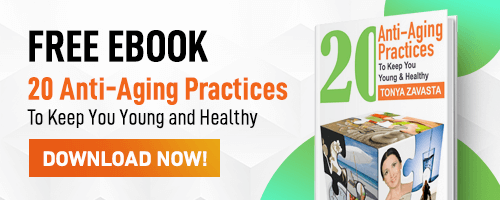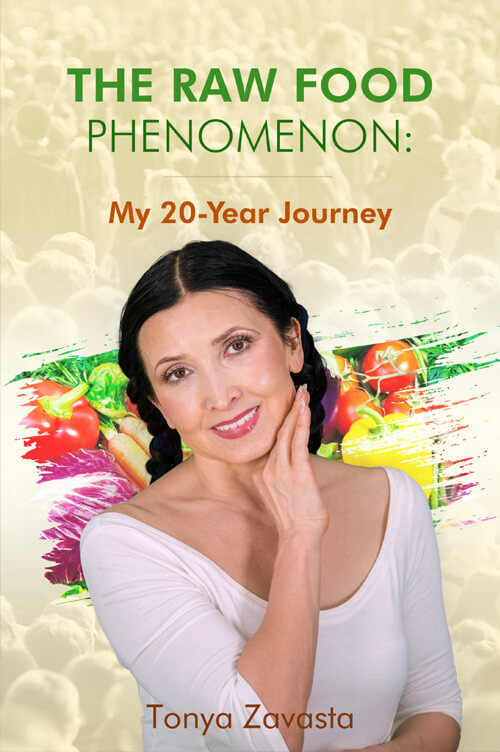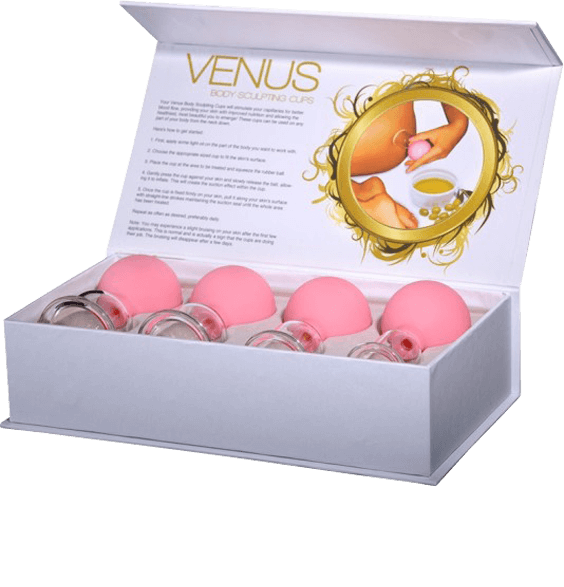How to Stop Height Loss with Age
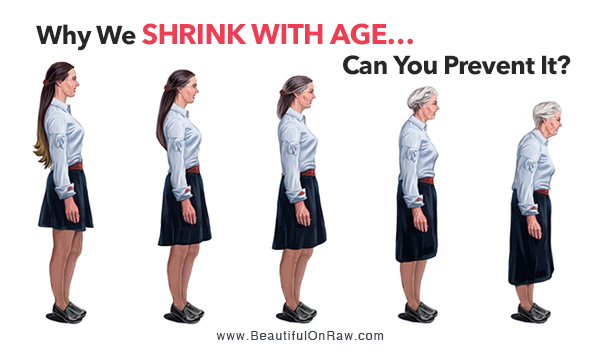
I thought of my mother…Where once she was taller than me, even once I hit adulthood, she is now shorter. I started to research.
Average height loss with age.
We start losing height—starting as early as age 30. Men lose up to an inch between ages 30 and 70. Women loose more than men—up to two inches. After age 80, men and women can lose up to another full inch.
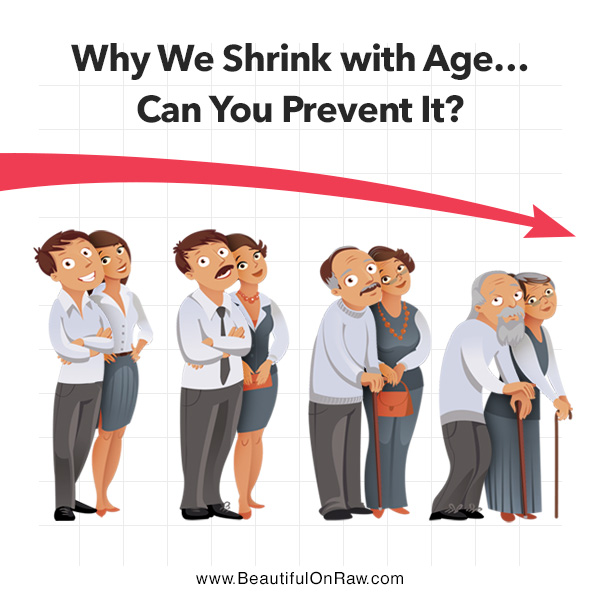
Our organs in general shrink with age. For example, in only the decade between ages 30 and 40, we typically lose 20% of our vital lung capacity. By age 50, we’ve lost almost 40%. Similarly, your heart changes shape, shrinks, and loses a good measure of its pumping function as ages.
All four basic tissue types—connective, epithelial (skin and the linings of the passages inside the body), muscle, and nerve—begin to shrink. The main cause is loss of water.
All human tissue shrinks with age. It doesn’t matter what type—connective tissue, epithelial (skin and the linings of passages inside the body), muscle, and nerves. It all sooner or later starts to shrink. The main cause: loss of water. That’s why everyone tells you to drink more water. But lots of people drink those perennially instructed eight glasses of water a day, and still they shrink.
Let me offer you an image…dried fruit and water. That’s what you get when you eat dehydrated food—cooked food—and then flush it down with lots of tap water. Your water must come from fresh fruits and vegetables. Only water that’s “alive” will make a difference.
Why do people get shorter with age?
There are several possibilities…
Cartilage between their spinal columns and joints gets worn out and compressed. The discs between vertebrae dehydrate and flatten, creating a curvature of the spine.
Osteoporosis, a condition in which bones become brittle and fragile from loss of tissue, typically as a result of hormonal changes, or deficiency of calcium or vitamin D, shortens the spinal column.
Sarcopenia is the loss of lean muscle mass plus the gain of fat, leading to weakness, shrinkage, and back pain. This can happen with or without the added complication of flat feet, which itself reduces height. How to deal with sarcopenia see this article: Muscle Loss Due to Aging How to Avoid it.
How to Stop Height Loss with Age
A man I once saw at the gym, well into his eighties, had an unusually straight back. Perhaps I was staring. I summoned the courage to ask him directly how he came by such good posture. Clearly, he’d often been asked before. His quick answer: He did passive hang on a pull-up bar every day for five minutes.
Before I proceed let me offer a warning:
As always, I share with you what I do as part of my own practice. I hold no certificates, have no medical or fitness training. Always consult your doctor, physical therapist, or other duly qualified practitioner before doing any exercises on this website. Use this website for ideas only. Nothing should ever hurt. If you feel any discomfort, stop immediately, and seek professional help.
Brachiating
“Man is the fifth great ape," - An orthopedic surgeon John M. Kirsch once said in an interview. Gibbons, gorillas, chimps, and orangutans all still swing from trees by the arms. It’s called brachiating—moving by using the arms to swing from branch to branch. When we humans moved out of the forest, we stopped brachiating, Kirsch noted. “But we still have the shoulders of an ape that’s supposed to brachiate.” Because our shoulders aren’t getting the exercise nature intended, they eventually weaken and become prone to injury.
Kirsch’s first patient was himself. In the 1980s, he developed an impingement in both shoulders. “I decided if I were to hang from a bar, I could squeeze the fluids out of the swollen tissues and reshape the arched bone that compresses the rotator cuff. After a little over a year, I completely relieved the pain in my shoulders.” His mobility also greatly improved.
It’s clear that hanging from a bar is good for your shoulders and upper arms. But is it good for other body parts? Short answer: Yes.
The spine is constantly under pressure. As we age, gravity compresses the vertebrae and slowly presses the spaces in between. This compression isn’t helped by other things we inflict on our spines, such as constant sitting, which throws the hips out of alignment. Hanging helps stretch the spine, which reduces compression, help alleviating back pain.
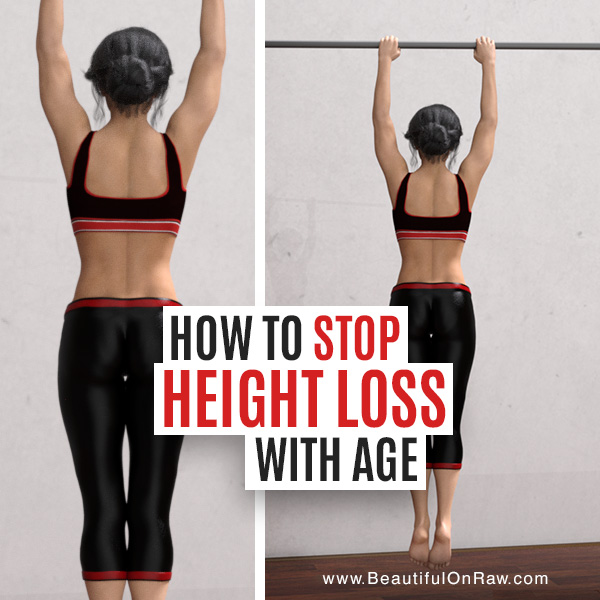
Hanging from a Pull-Up Bar
There are two types of hangs you can perform: passive and active.
Passive hang is exactly what the name implies. There’s no motion involved. You simply hang from a bar high enough off the ground that your feet cannot touch it even with your arms fully extended over your head.
To perform a passive hang correctly, grip the bar overhand—never underhand—and be sure to position your hands shoulders-width apart. This will make your hang a straight one—you don’t want the “Y” shape that comes from a grip too widely spaced. Once you’re sure of your grip, relax all your muscles so that you are “dead weight,” just hanging.
Sounds simple enough. But, yes, you can do it wrong. One common mistake: failing to fully relax the muscles during the hang. Two other classic errors: bending elbows and having more tension in the hands and arms than is needed to hold onto the bar.
In mastering the passive hang, you’ll enjoy posture-improving benefits, such as a straighter, de-compressed spine, stronger shoulders and arms, and improved muscles, joints, and ligaments. Hanging passively reminds your body of what it experienced, and probably enjoyed, when you were younger and playing on playground monkey bars. Your body may be older now, but it can look and feel much younger by engaging in motion that makes you feel more flexible, more limber, and reverses the forward slouch so many of us develop later in life thanks to spine compression.
Active hanging starts out in a way similar to the passive hang. The departure: Once you’ve relaxed your body, re-engage your muscles as if about to begin a pull up, hold that briefly, then relax your muscles again. Repeat this process for the whole duration of your hang.
The most common mistake made in the active hang is bending the elbows. You’re not actually doing a pull up. Thus your elbows should never actually be bent. The activity in the active hang is the engaging and relaxing of the muscles during your hang.
Beyond the posture-improving benefits of the passive hang, the active hang will improve your upper-body strength.
So what equipment do you need for hangs?
You’ll want a pair of exercise gloves to help you with your grip. These are easily found, and there are many types that are affordable. Make sure you get a good fit.
Next, you’ll need a bar. I’ve read about people doing hangs from door frames and transoms. Don’t. Ever. It’s downright dangerous, not to mention uncomfortable.
Some people get pull-up bars that they affix in a doorway. Allieroo offers one for under $20, as does Gold’s Gym. Keep in mind that when you do hangs in a doorway, you will have to bend your knees, holding your legs up, which may have an impact on how effective your hangs are, because the goal is to hang with all your muscles relaxed.
There’s a more expensive option that will free you from the bent-knees issue. Rogue Fitness makes a bar that you can attach to a wall, at the height of your choice. It can even attach to rafters if you happen to have exposed rafters in a garage or utility building.
Once you have your equipment, you can start hanging. Take it slow! Start your daily hangs at ten seconds each for the first week. Then up them to 15 seconds the second week, 20 the third week, and so on. It’s going to take time to build up to the five-minute passive hangs my octogenarian friend was doing. But I promise you this: You’ll start to feel the benefits and see the difference in your posture very early on.
Cupping massage as means to stop shrinking
Add in the practice of the cupping massage. Start gently. But as you skin gets used to it, you can indulge as much as you like. A good cupping massage fluffs up the underlying tissues of your skin, preventing your skin from thinning and drying up. It will keep your skin moist and encourage its rejuvenation.
